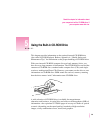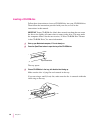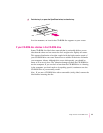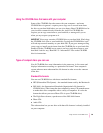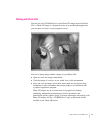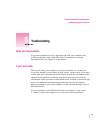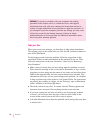
Obtaining Photo CDs
Your own photographs can be recorded as Photo CD images on a Photo CD.
To obtain a Photo CD of your own photographs, take your standard 35-mm
film to a photofinisher who has a Photo CD system. The photofinisher
develops your film, digitizes the photographs, and gives you back a Photo CD
containing your images. A single Photo CD can hold approximately one
hundred images.
If your Photo CD isn’t full, you can take it back to the photofinisher and
have more photos added until the disc is full. Such discs are called
multisession discs because they contain images added after the first session.
Your CD-ROM drive can read both single-session and multisession Photo
CDs. (Other CD-ROM drives can read only single-session discs and are
unable to read the additional images placed on a multisession disc.)
Before viewing the contents of a Photo CD
Normally, you open Photo CD images with the SimpleText program that came
with your computer. If you wish, you can use a graphics or image-editing
program instead of SimpleText. For instructions, see the “CD-ROM Discs”
topic of Macintosh Guide, available in the Guide (h) menu. If you use
SimpleText to view high-resolution images, you should increase the amount of
memory that SimpleText uses. For more information on memory, see the
“Memory” topic of Macintosh Guide, available in the Guide (h) menu.
A note about resolution
When a Photo CD image is created, it’s recorded at five different levels of
resolution. The higher the resolution, the more information is recorded about
the image, and the sharper the image appears when displayed or printed at
larger sizes. However, high-resolution images take up a lot of memory—up to
18 MB of data for one photograph—which affects file size, as well as the
amount of time it takes to display or print an image.
It’s best to work with a resolution appropriate for your monitor or
printer. Some monitors and printers cannot display or print very high-
resolution images.
72
Chapter 5




